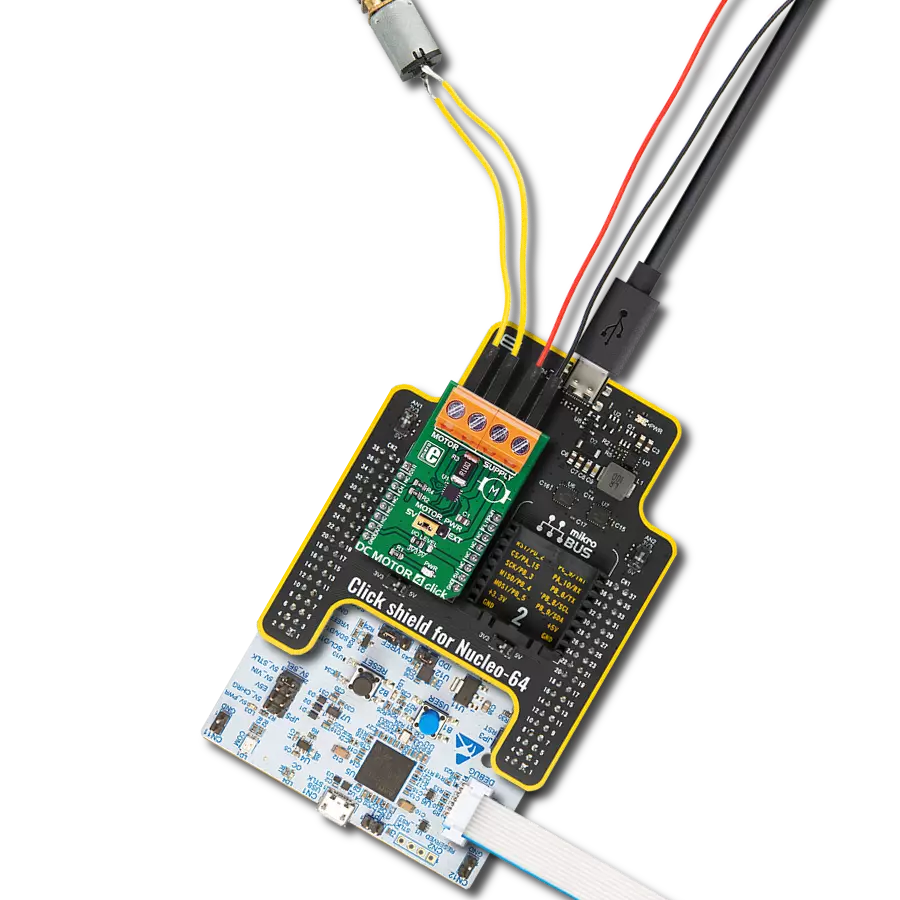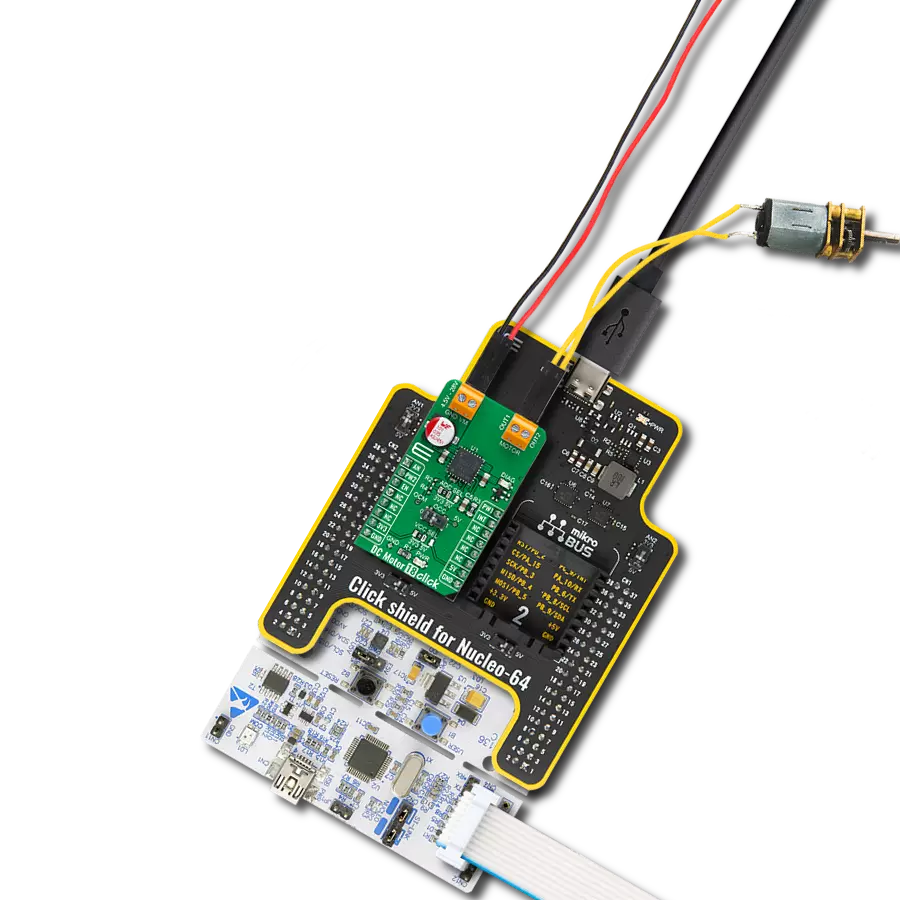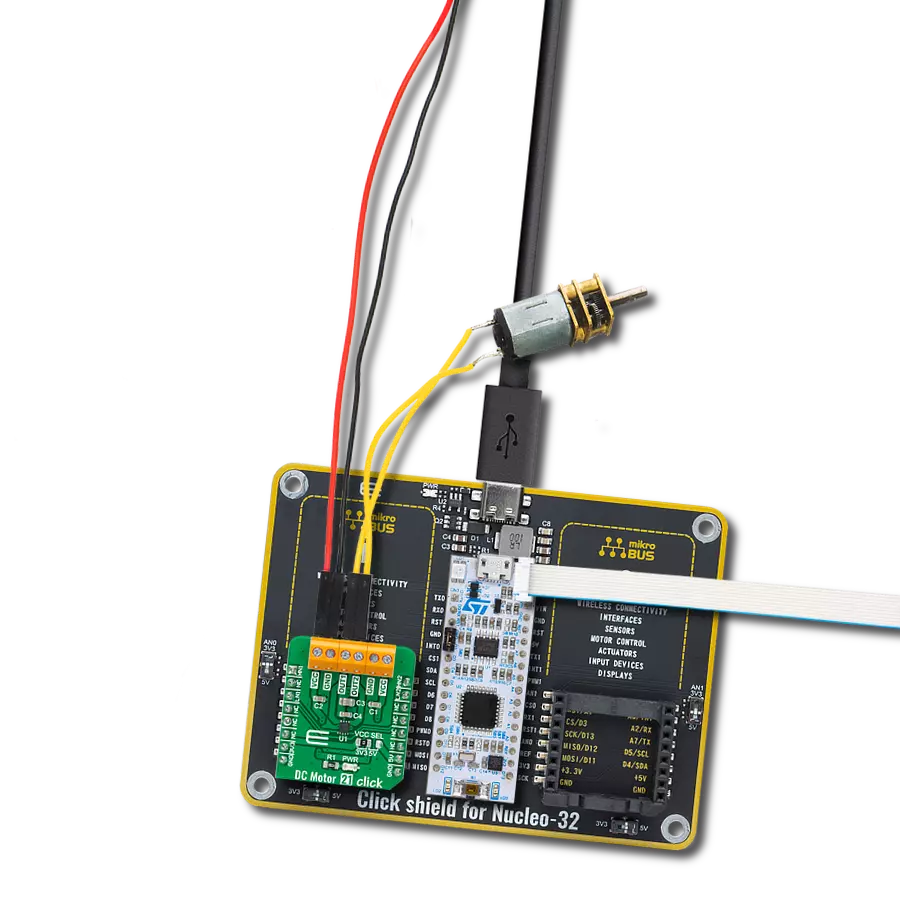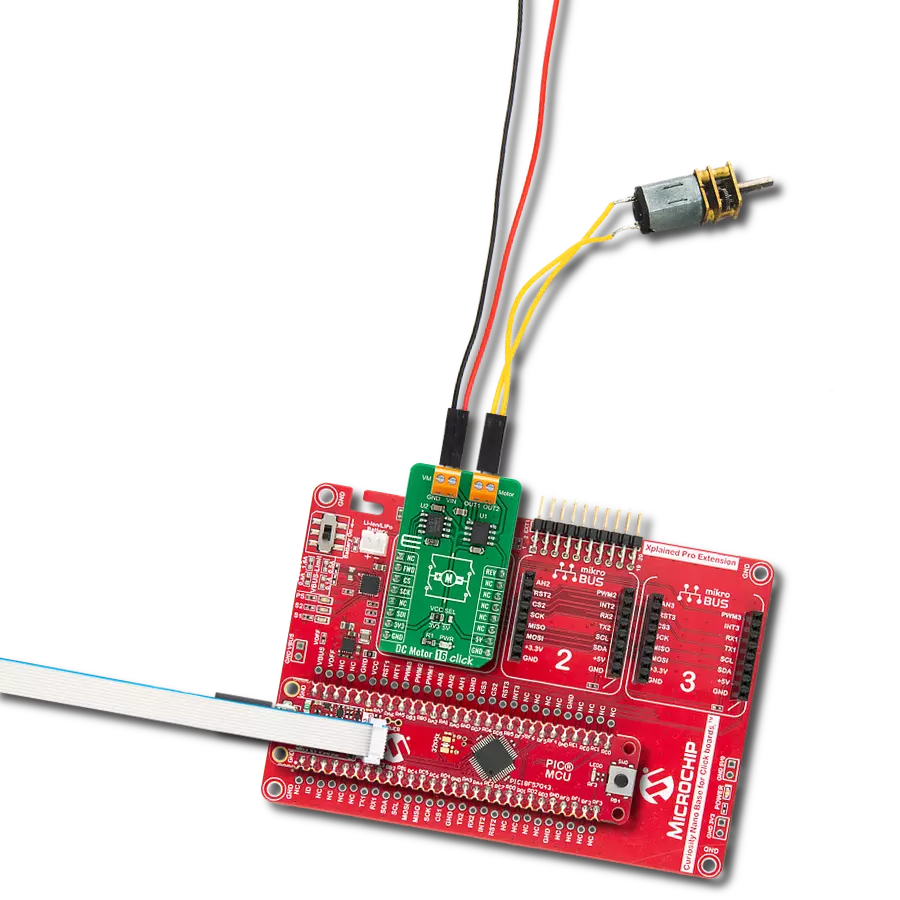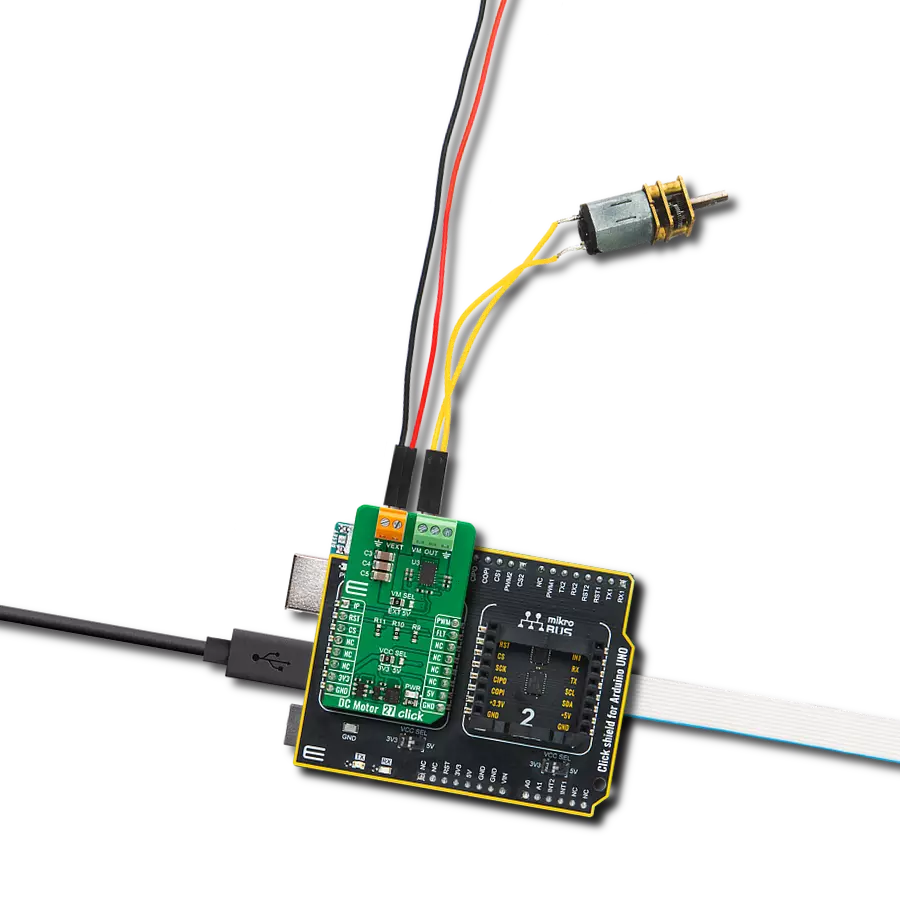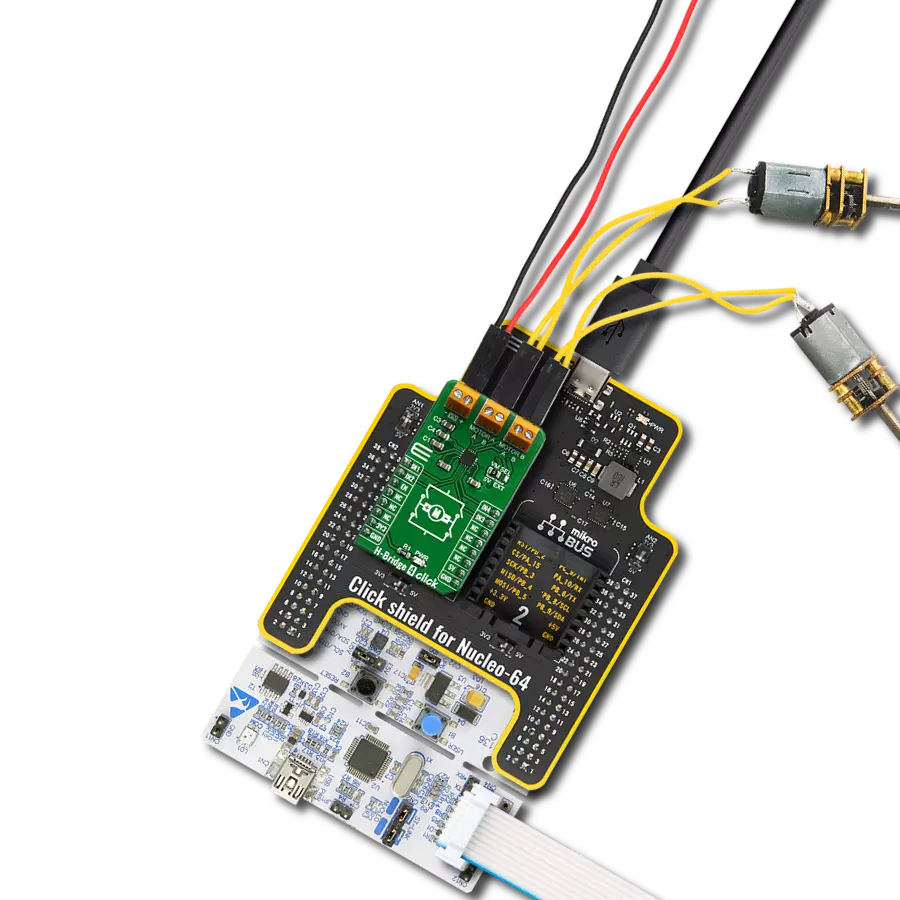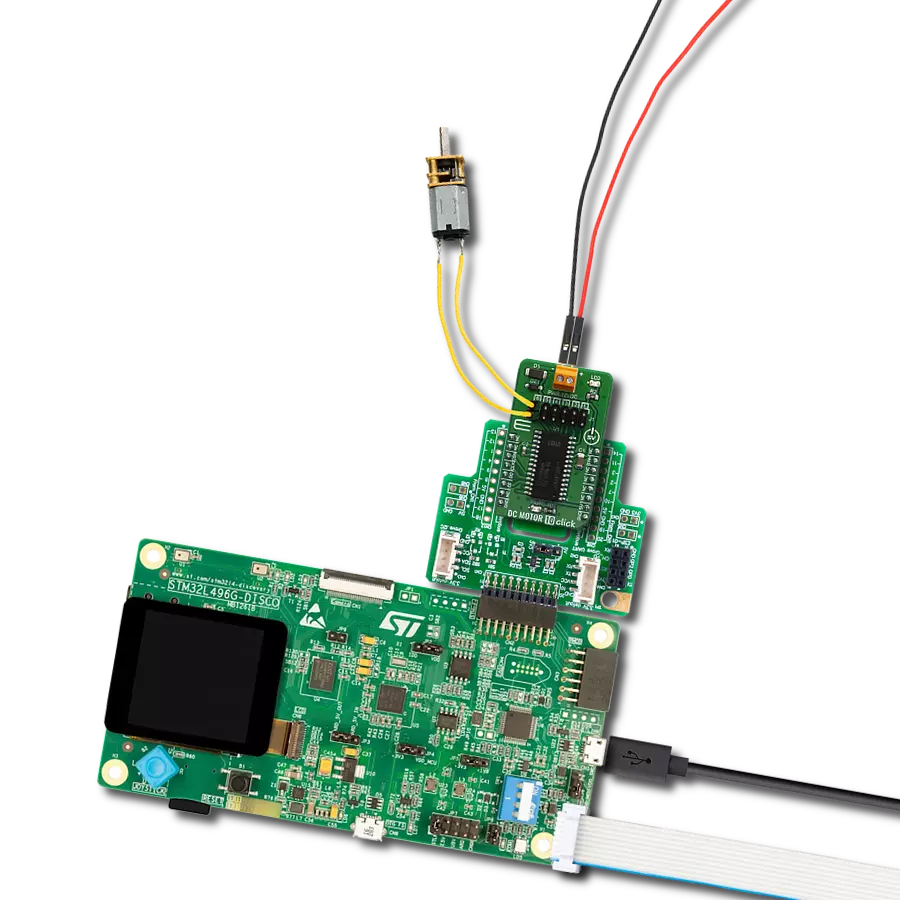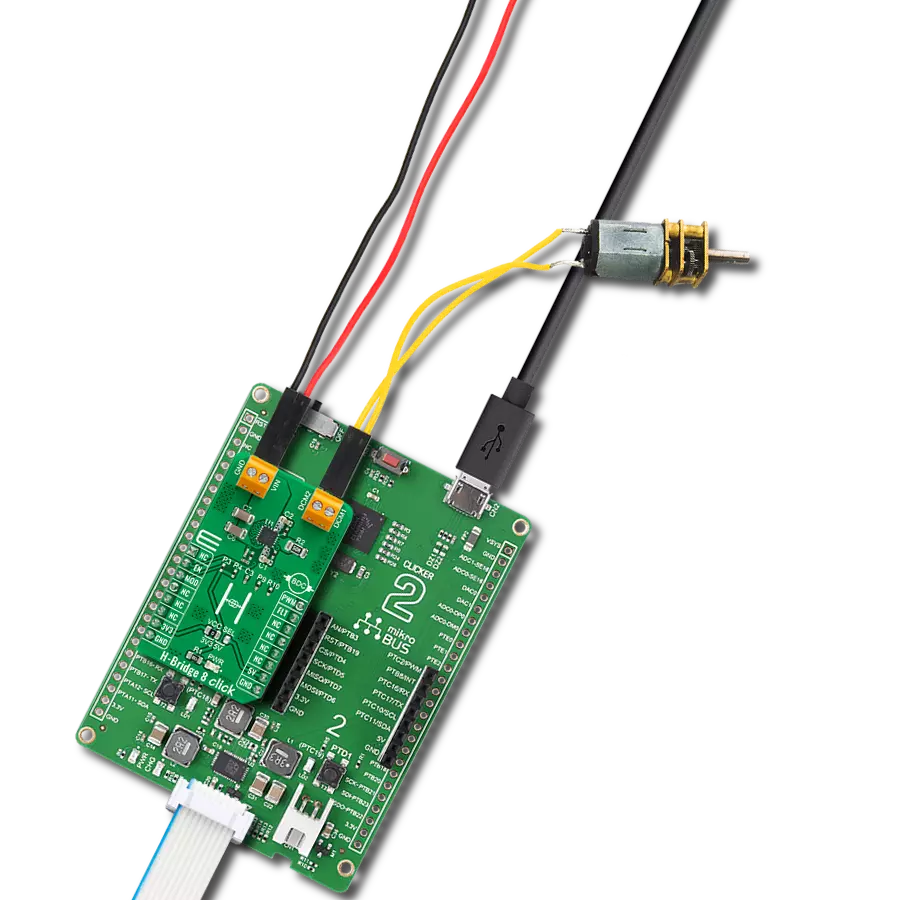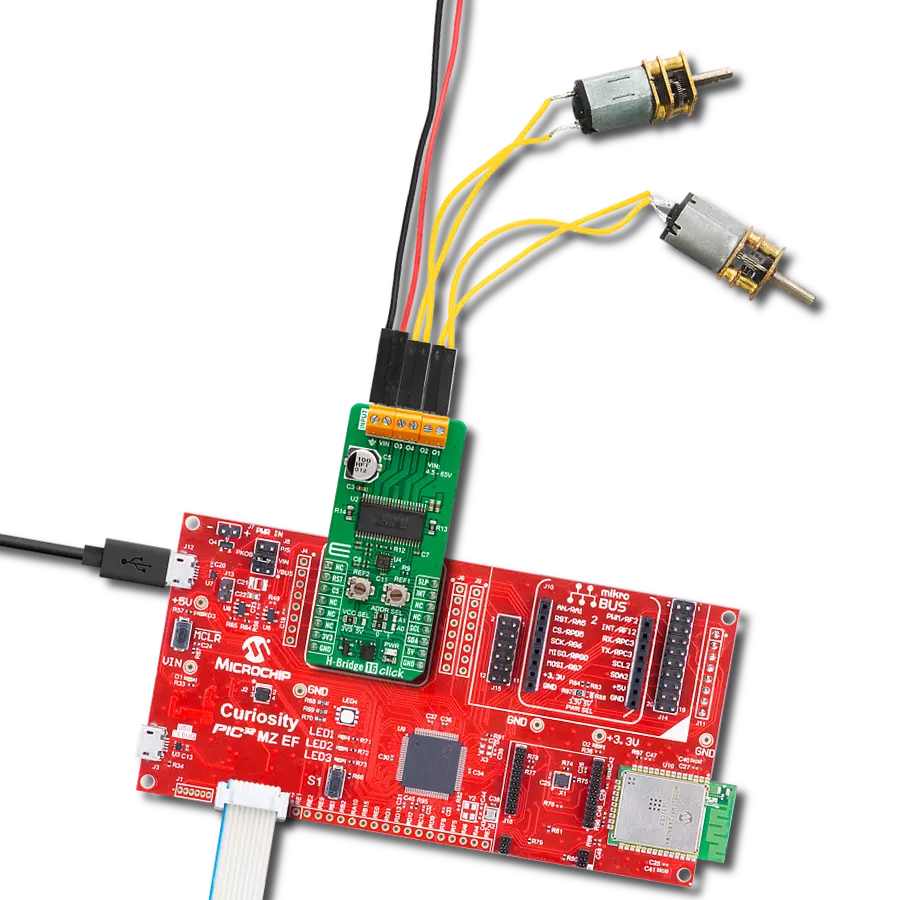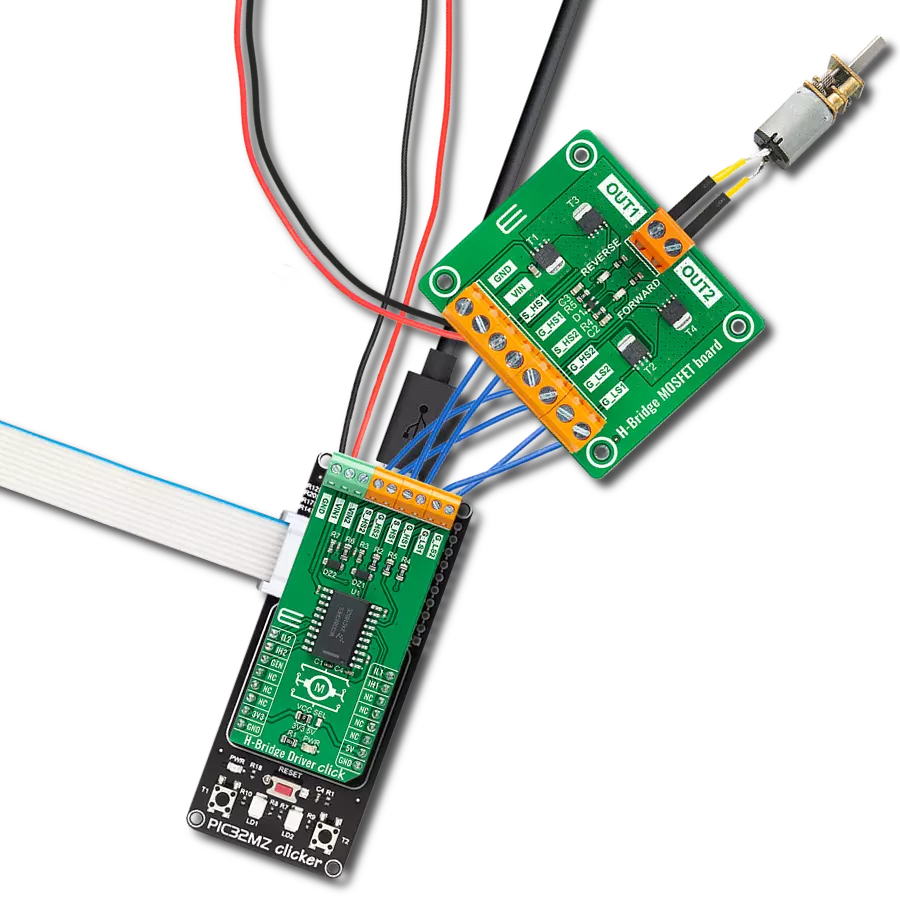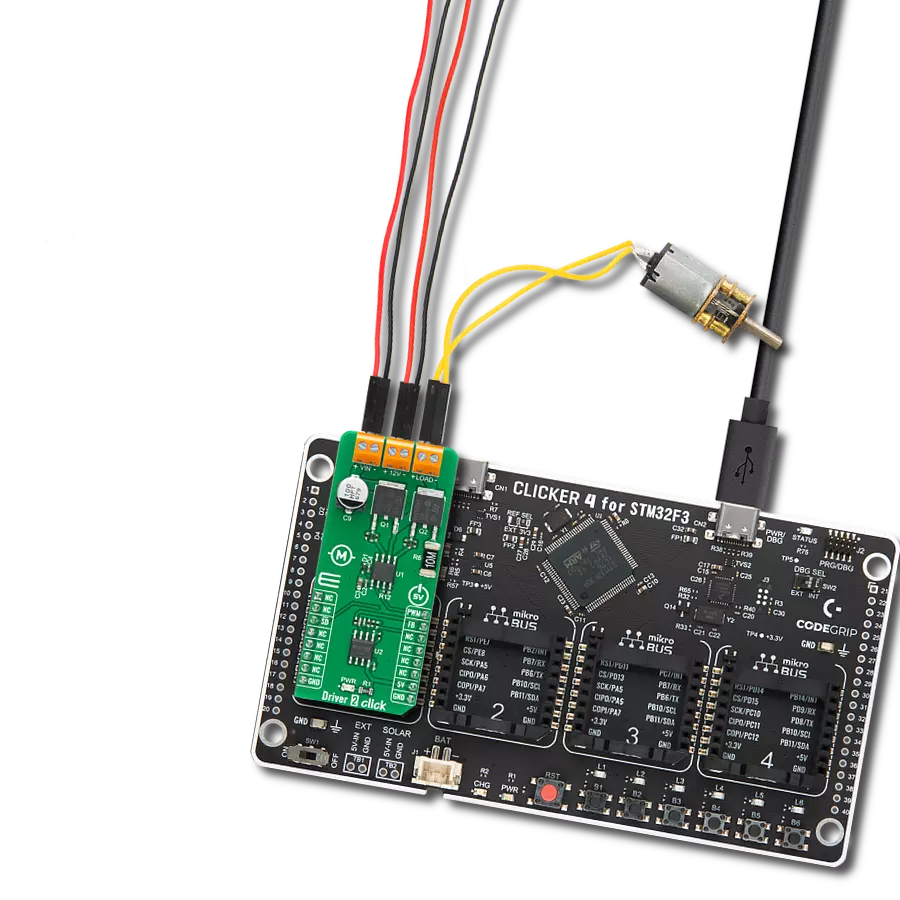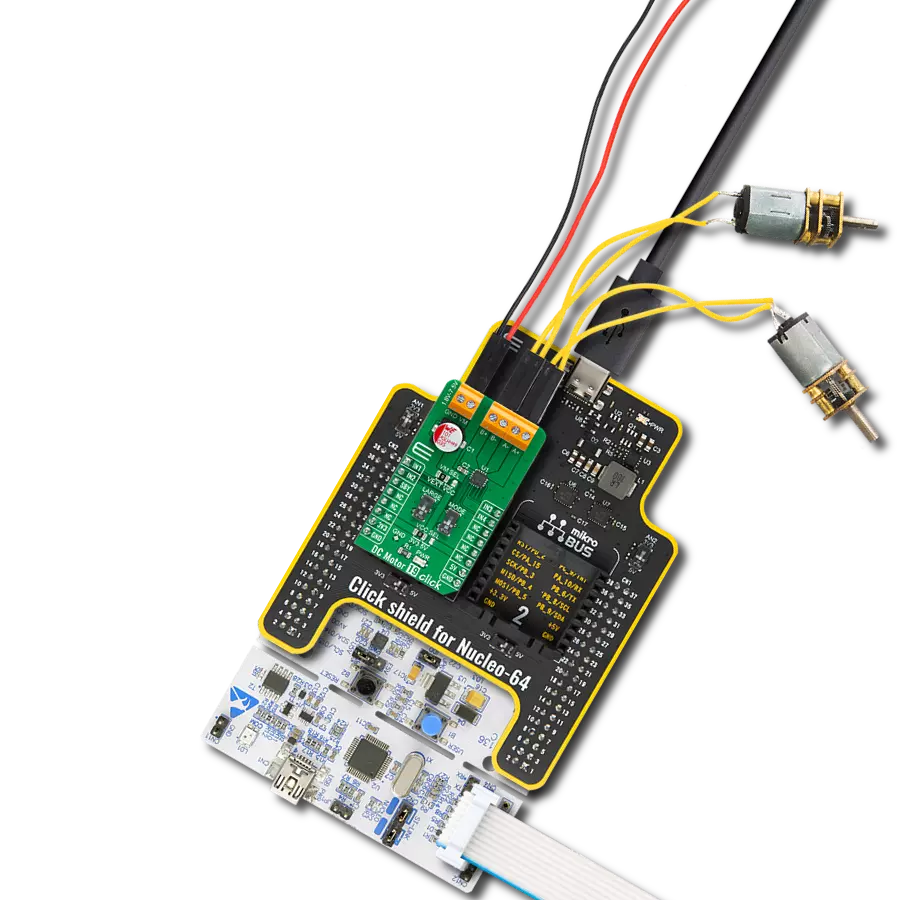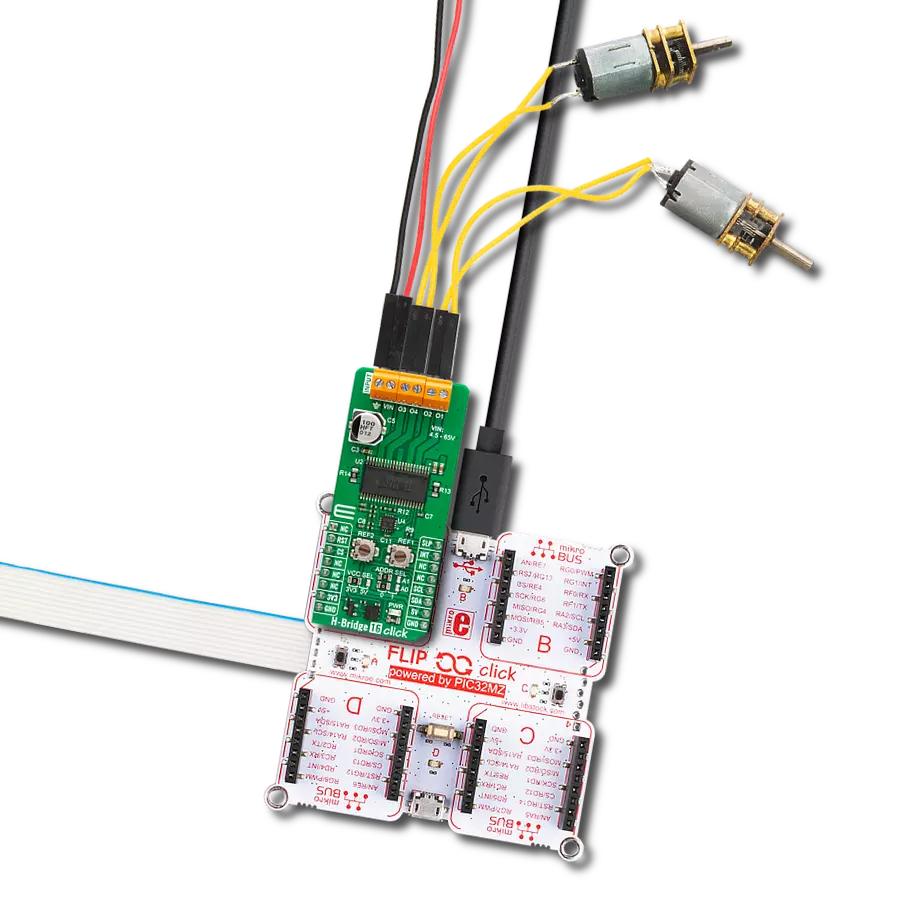Elevate your engineering prowess with tailor-made motor control through our cutting-edge "H-Bridge" drive solution. Take the first step towards unmatched performance and efficiency by incorporating this customizable innovation into your project today.
A
A
Hardware Overview
How does it work?
DC Motor 5 Click is based on the DRV8701 brushed DC motor gate driver from Texas Instruments. The Click is designed to run on an external power supply. It communicates with the target MCU over the following pins on the mikroBUS™ line: AN, RST, CS, PWM, and INT. The DRV8701 is an
H-bridge gate driver (a pre-driver or controller). The device integrates FET gate drivers to control four external NMOS FETs. The device can be powered with a supply voltage between 5.9V and 45V. Internal protection functions are provided: under-voltage lockout, charge pump faults,
overcurrent shutdown, short-circuit protection, pre-driver faults, and overtemperature. The motor's velocity and direction can be adjusted with two PWM input signals.
Features overview
Development board
Nucleo-64 with STM32G071RB MCU offers a cost-effective and adaptable platform for developers to explore new ideas and prototype their designs. This board harnesses the versatility of the STM32 microcontroller, enabling users to select the optimal balance of performance and power consumption for their projects. It accommodates the STM32 microcontroller in the LQFP64 package and includes essential components such as a user LED, which doubles as an ARDUINO® signal, alongside user and reset push-buttons, and a 32.768kHz crystal oscillator for precise timing operations. Designed with expansion and flexibility in mind, the Nucleo-64 board features an ARDUINO® Uno V3 expansion connector and ST morpho extension pin
headers, granting complete access to the STM32's I/Os for comprehensive project integration. Power supply options are adaptable, supporting ST-LINK USB VBUS or external power sources, ensuring adaptability in various development environments. The board also has an on-board ST-LINK debugger/programmer with USB re-enumeration capability, simplifying the programming and debugging process. Moreover, the board is designed to simplify advanced development with its external SMPS for efficient Vcore logic supply, support for USB Device full speed or USB SNK/UFP full speed, and built-in cryptographic features, enhancing both the power efficiency and security of projects. Additional connectivity is
provided through dedicated connectors for external SMPS experimentation, a USB connector for the ST-LINK, and a MIPI® debug connector, expanding the possibilities for hardware interfacing and experimentation. Developers will find extensive support through comprehensive free software libraries and examples, courtesy of the STM32Cube MCU Package. This, combined with compatibility with a wide array of Integrated Development Environments (IDEs), including IAR Embedded Workbench®, MDK-ARM, and STM32CubeIDE, ensures a smooth and efficient development experience, allowing users to fully leverage the capabilities of the Nucleo-64 board in their projects.
Microcontroller Overview
MCU Card / MCU
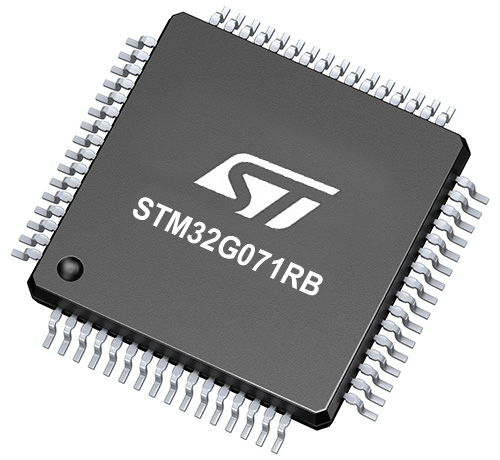
Architecture
ARM Cortex-M0
MCU Memory (KB)
128
Silicon Vendor
STMicroelectronics
Pin count
64
RAM (Bytes)
36864
You complete me!
Accessories
Click Shield for Nucleo-64 comes equipped with two proprietary mikroBUS™ sockets, allowing all the Click board™ devices to be interfaced with the STM32 Nucleo-64 board with no effort. This way, Mikroe allows its users to add any functionality from our ever-growing range of Click boards™, such as WiFi, GSM, GPS, Bluetooth, ZigBee, environmental sensors, LEDs, speech recognition, motor control, movement sensors, and many more. More than 1537 Click boards™, which can be stacked and integrated, are at your disposal. The STM32 Nucleo-64 boards are based on the microcontrollers in 64-pin packages, a 32-bit MCU with an ARM Cortex M4 processor operating at 84MHz, 512Kb Flash, and 96KB SRAM, divided into two regions where the top section represents the ST-Link/V2 debugger and programmer while the bottom section of the board is an actual development board. These boards are controlled and powered conveniently through a USB connection to program and efficiently debug the Nucleo-64 board out of the box, with an additional USB cable connected to the USB mini port on the board. Most of the STM32 microcontroller pins are brought to the IO pins on the left and right edge of the board, which are then connected to two existing mikroBUS™ sockets. This Click Shield also has several switches that perform functions such as selecting the logic levels of analog signals on mikroBUS™ sockets and selecting logic voltage levels of the mikroBUS™ sockets themselves. Besides, the user is offered the possibility of using any Click board™ with the help of existing bidirectional level-shifting voltage translators, regardless of whether the Click board™ operates at a 3.3V or 5V logic voltage level. Once you connect the STM32 Nucleo-64 board with our Click Shield for Nucleo-64, you can access hundreds of Click boards™, working with 3.3V or 5V logic voltage levels.
DC Gear Motor - 430RPM (3-6V) represents an all-in-one combination of a motor and gearbox, where the addition of gear leads to a reduction of motor speed while increasing the torque output. This gear motor has a spur gearbox, making it a highly reliable solution for applications with lower torque and speed requirements. The most critical parameters for gear motors are speed, torque, and efficiency, which are, in this case, 520RPM with no load and 430RPM at maximum efficiency, alongside a current of 60mA and a torque of 50g.cm. Rated for a 3-6V operational voltage range and clockwise/counterclockwise rotation direction, this motor represents an excellent solution for many functions initially performed by brushed DC motors in robotics, medical equipment, electric door locks, and much more.
Used MCU Pins
mikroBUS™ mapper
Take a closer look
Click board™ Schematic

Step by step
Project assembly
Software Support
Library Description
This library contains API for DC Motor 5 Click driver.
Key functions:
dcmotor5_short_brake- Function brakes the engine by setting IN1 ( PWM ) and IN2 ( INT ) pins on DC Motor 5 Clickdcmotor5_stop- Function stops the engine by clearing IN1 ( PWM ) and IN2 ( INT ) pins on DC Motor 5 Clickdcmotor5_enable- Function disables the engine by clearing SLEEP ( RST ) pin on DC Motor 5 Click
Open Source
Code example
The complete application code and a ready-to-use project are available through the NECTO Studio Package Manager for direct installation in the NECTO Studio. The application code can also be found on the MIKROE GitHub account.
/*!
* @file main.c
* @brief DCMotor5 Click example
*
* # Description
* This library contains API for the DC Motor 5 Click driver.
* This application enables usage of brushed DC motor 5 gate driver.
*
* The demo application is composed of two sections :
*
* ## Application Init
* Initializes GPIO, PWM and logger and enables the Click board.
*
* ## Application Task
* This is a example which demonstrates the use of DC Motor 5 Click board.
* DC Motor 5 Click controls DC Motor speed via PWM interface.
* It shows moving in the both directions from slow to fast speed
* and from fast to slow speed.
* Results are being sent to the Usart Terminal where you can track their changes.
*
* @author Nikola Peric
*
*/
#include "board.h"
#include "log.h"
#include "dcmotor5.h"
// ------------------------------------------------------------------ VARIABLES
static dcmotor5_t dcmotor5;
static log_t logger;
uint8_t dcmotor_direction = 1;
// ------------------------------------------------------ APPLICATION FUNCTIONS
void application_init ( void )
{
log_cfg_t log_cfg;
dcmotor5_cfg_t cfg;
/**
* Logger initialization.
* Default baud rate: 115200
* Default log level: LOG_LEVEL_DEBUG
* @note If USB_UART_RX and USB_UART_TX
* are defined as HAL_PIN_NC, you will
* need to define them manually for log to work.
* See @b LOG_MAP_USB_UART macro definition for detailed explanation.
*/
LOG_MAP_USB_UART( log_cfg );
log_init( &logger, &log_cfg );
log_info( &logger, "---- Application Init ----" );
// Click initialization.
dcmotor5_cfg_setup( &cfg );
DCMOTOR5_MAP_MIKROBUS( cfg, MIKROBUS_1 );
dcmotor5_init( &dcmotor5, &cfg );
log_printf( &logger, " Initialization PWM \r\n" );
dcmotor5_pwm_start( &dcmotor5 );
dcmotor5_enable ( &dcmotor5 );
Delay_ms ( 500 );
log_printf( &logger, "---------------------\r\n" );
log_info( &logger, "---- Application Task ----" );
}
void application_task ( )
{
static float duty;
static uint8_t n_cnt;
dcmotor5_clockwise ( &dcmotor5 );
log_printf( &logger, "\r\n> CLOCKWISE <\r\n" );
dcmotor5_enable ( &dcmotor5 );
for ( n_cnt = 10; n_cnt > 0; n_cnt-- )
{
duty = ( float ) n_cnt ;
duty /= 10;
log_printf( &logger, " >" );
dcmotor5_set_duty_cycle( &dcmotor5, duty );
Delay_ms ( 500 );
}
for ( n_cnt = 1; n_cnt <= 10; n_cnt++ )
{
duty = ( float ) n_cnt ;
duty /= 10;
log_printf( &logger, " <" );
dcmotor5_set_duty_cycle( &dcmotor5, duty );
Delay_ms ( 500 );
}
log_printf( &logger, "\r\n * Pull break *\r\n" );
dcmotor5_short_brake( &dcmotor5 );
Delay_ms ( 1000 );
dcmotor5_counter_clockwise ( &dcmotor5 );
log_printf( &logger, "\r\n> COUNTER CLOCKWISE <\r\n" );
for ( n_cnt = 1; n_cnt <= 10; n_cnt++ )
{
duty = ( float ) n_cnt ;
duty /= 10;
dcmotor5_set_duty_cycle( &dcmotor5, duty );
log_printf( &logger, " >" );
Delay_ms ( 500 );
}
for ( n_cnt = 10; n_cnt > 0; n_cnt-- )
{
duty = ( float ) n_cnt ;
duty /= 10;
dcmotor5_set_duty_cycle( &dcmotor5, duty );
log_printf( &logger, " <" );
Delay_ms ( 500 );
}
}
int main ( void )
{
/* Do not remove this line or clock might not be set correctly. */
#ifdef PREINIT_SUPPORTED
preinit();
#endif
application_init( );
for ( ; ; )
{
application_task( );
}
return 0;
}
// ------------------------------------------------------------------------ END
Additional Support
Resources
Category:Brushed




















